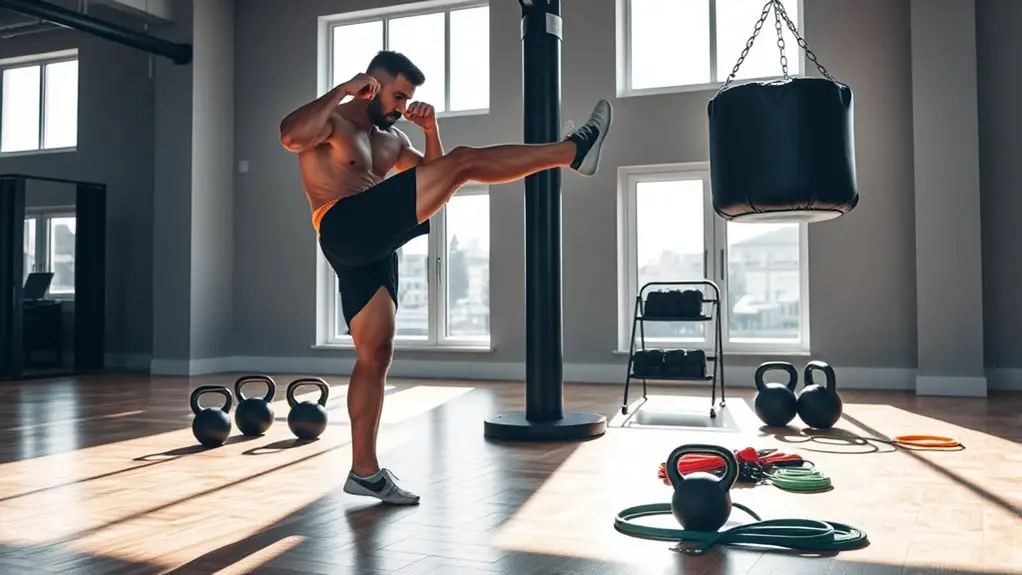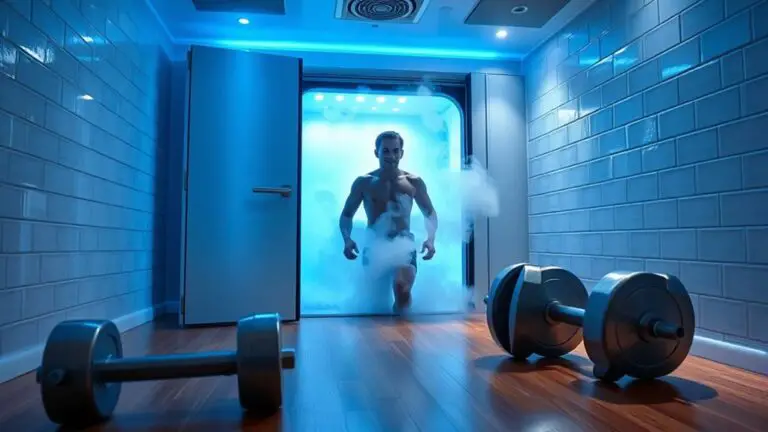How to Improve Kicking Power Through Strength Training

To improve your kicking power through strength training, focus on engaging key muscle groups like your quadriceps and hamstrings. Incorporate essential exercises like squats, deadlifts, and lunges, and supplement them with plyometric drills such as box jumps for explosive strength. Don’t forget flexibility and mobility training to support recovery and performance. By systematically tracking your progress and adjusting your workouts, you’ll optimize your results. There’s much more to explore for refined techniques and thorough strategies.
Understanding the Mechanics of Kicking

Kicking is a complex interplay of biomechanics that requires precision and power. To effectively improve your kicking, you need to focus on your kicking techniques and guarantee ideal body alignment. Each kick begins with a proper stance; your feet should be shoulder-width apart, allowing for a stable foundation. As you prepare to strike, engage your core to maintain balance and stability throughout the motion.
Your non-kicking leg plays an essential role in guiding your body alignment. Keep your hips squared towards the target, which enhances accuracy and power. During the kick, your kicking leg should move in a fluid, controlled manner, allowing the knee to rise before extending the foot for contact. This sequence is critical; each component must synchronize to maximize force. By meticulously analyzing and refining these techniques, you’ll not only boost your kicking power but also develop a deeper understanding of the mechanics at play.
Key Muscles Involved in Kicking
To maximize your kicking power, understanding the key muscles involved is essential. The quadriceps drive the initial force, while the hamstrings play an important role in controlling the movement. Additionally, core stability is crucial for maintaining balance and transferring energy efficiently throughout the kick.
Quadriceps Muscle Function
The quadriceps, a group of four powerful muscles located at the front of your thigh, play an essential role in generating kicking power. To enhance your kicking ability, focusing on quadriceps strength is vital. Strong quadriceps contribute to explosive leg extension, allowing you to deliver a more powerful kick. Incorporating targeted strength training exercises like squats and lunges can greatly improve muscle activation and endurance. However, it’s equally important to prioritize muscle recovery post-training. Adequate rest and recovery strategies, such as stretching and proper nutrition, help prevent injury and guarantee your quadriceps remain in peak condition. By balancing strength training and recovery, you’ll maximize your kicking potential and elevate your performance on the field.
Hamstrings Role Explained
Essential to the kicking motion, the hamstrings play a pivotal role in generating power and stability. These muscles, located at the back of your thigh, are essential for hip extension and knee flexion, both integral during a kick. To maximize your kicking power, you need to focus on hamstring strengthening techniques, such as deadlifts and leg curls. These exercises not only enhance muscle strength but also contribute to hamstring injury prevention, ensuring you stay in the game longer. Incorporating plyometric movements can further improve explosiveness, translating directly to your kicking ability. By prioritizing hamstring development, you’ll achieve greater control and force, ultimately elevating your performance on the field. So, invest time in this critical muscle group!
Core Stability Importance
While many focus solely on leg strength for kicking power, core stability is equally vital. Your core acts as a central hub, transferring energy from your upper body to your legs during a kick. The key muscles involved—abdominals, obliques, and lower back—enhance core strength, allowing for better control and balance. When you engage in stability training, you’re not just building muscle; you’re reinforcing the coordination necessary for powerful kicks. A strong core supports your hips and pelvis, optimizing your kicking mechanics and reducing injury risk. So, don’t overlook this essential component. By integrating core stability exercises into your routine, you’ll maximize your kicking power, leading to improved performance on the field. Embrace the challenge and elevate your game!
Essential Strength Training Exercises
To maximize your kicking power, integrating specific strength training exercises into your routine is essential. A combination of bodyweight exercises and resistance training can greatly enhance your strength and explosiveness. Focus on compound movements that engage multiple muscle groups.
Here’s a quick reference table for essential exercises:
| Exercise | Type | Benefits |
|---|---|---|
| Squats | Bodyweight | Builds leg strength |
| Deadlifts | Resistance Training | Enhances posterior chain |
| Lunges | Bodyweight | Improves balance and power |
| Leg Press | Resistance Training | Increases leg drive |
| Planks | Bodyweight | Strengthens core stability |
Incorporating these exercises into your routine not only builds strength but also boosts your overall athleticism. Remember, consistent training is the key to revealing your full kicking potential!
Plyometric Drills for Explosive Power

Plyometric drills like box jumps and medicine ball throws are essential for developing explosive power in your kicks. By incorporating these exercises, you’ll enhance your fast-twitch muscle fibers, leading to quicker, more powerful movements. Let’s explore how these drills can greatly boost your kicking performance.
Box Jumps Benefits
Box jumps are an integral component of plyometric training, offering numerous benefits for enhancing explosive power in athletes. By incorporating box jumps into your routine, you’ll develop explosive strength in your lower body, vital for improving kicking power. This exercise engages fast-twitch muscle fibers, promoting rapid force production necessary for powerful movements. As you progress, you’ll experience increased vertical leap and improved overall athletic performance. Furthermore, box jumps enhance coordination and balance, essential traits for any athlete. To maximize results, focus on proper technique, including a strong landing position. Regularly including these jumps in your workout can lead to significant improvements in your explosive strength, which directly translates to more powerful kicks on the field. Get ready to elevate your game!
Medicine Ball Throws
Release your explosive potential with medicine ball throws, a powerful plyometric drill that can greatly enhance your kicking strength. By incorporating various medicine ball varieties, such as the chest pass, overhead throw, and rotational throw, you’ll engage multiple muscle groups. Focus on performing each throw with an explosive push, driving the ball away with maximum force.
This not only builds muscular power but also improves coordination and stability, vital for effective kicking. Aim for high-intensity sessions, integrating these throws into your routine two to three times a week. As you master these techniques, you’ll notice significant improvements in your power output and overall athletic performance. Embrace this dynamic exercise to elevate your kicking capabilities to new heights.
Incorporating Flexibility and Mobility
While strength is essential for enhancing kicking power, incorporating flexibility and mobility into your training regimen can greatly elevate your performance. Improving your range of motion allows for more explosive kicks, reducing the risk of injury. Here’s how you can integrate flexibility and mobility effectively:
- Dynamic stretching before workouts to increase blood flow and prepare your muscles.
- Static stretching post-training to enhance flexibility and promote muscle recovery.
- Incorporate yoga or Pilates sessions for improved balance and core strength.
- Use foam rolling techniques as part of your active recovery to alleviate muscle tightness.
- Implement mobility drills regularly to guarantee your joints can move freely and efficiently.
Creating a Balanced Training Program

To maximize your kicking power, it’s crucial to create a balanced training program that incorporates strength, flexibility, and endurance. Implementing periodization strategies helps in systematically varying your training intensity and volume, which can prevent plateaus and enhance your performance.
Here’s a structured approach to bear in mind:
| Component | Frequency | Focus |
|---|---|---|
| Strength | 2-3 times a week | Heavy lifts, explosive drills |
| Flexibility | 3-5 times a week | Dynamic and static stretches |
| Endurance | 2-3 times a week | Aerobic conditioning |
Tracking Your Progress and Adjusting Workouts
Monitoring your progress is essential for optimizing your kicking power and ensuring your training program remains effective. By implementing progress tracking techniques, you can identify strengths and weaknesses, allowing for targeted workout adjustments. Here’s how to effectively monitor your progress:
- Keep a training log: Document your workouts, sets, reps, and weights.
- Use performance metrics: Measure your kick distance and accuracy regularly.
- Set specific goals: Create short-term and long-term objectives to focus your training.
- Analyze trends: Look for patterns in your performance to identify what’s working and what’s not.
- Seek feedback: Collaborate with coaches or peers to gain insights into your technique.
Frequently Asked Questions
How Long Does It Take to See Improvements in Kicking Power?
When you’re focusing on improving kicking power, you might wonder how long it takes to see results. Typically, with consistent training frequency and attention to kicking biomechanics, you could notice improvements within a few weeks. However, individual progress may vary based on your current strength level and dedication. Stay motivated, track your progress, and adjust your training regimen as needed to maximize your gains and elevate your kicking performance.
Should I Focus on Upper Body Strength for Kicking?
Sure, you could focus on upper body strength for kicking; after all, who doesn’t love a robust upper body while delivering a powerful kick? But let’s be real—your lower body’s where the magic happens. Kicking power primarily relies on strong legs and hips. Neglecting your lower body means missing out on explosive strength. So, while you’re at it, balance your training to guarantee both upper and lower body work in harmony for peak kicking performance.
Can Diet Influence My Kicking Power?
Absolutely, your diet can greatly influence your kicking power. Focus on nutrient timing; consuming the right nutrients before and after training can maximize energy and recovery. Carbohydrates boost performance, while protein aids muscle repair. Don’t forget hydration strategies; staying well-hydrated enhances muscle function and overall performance. By optimizing your diet, you’re setting yourself up for improved strength and explosiveness in your kicks, ultimately enhancing your game on the field.
What Are Common Mistakes in Strength Training for Kickers?
Are you making the most of your strength training? Common mistakes for kickers often include neglecting proper kicking technique and failing to address muscle imbalances. If you focus solely on building strength without ensuring your form is correct, you might not see the results you want. Additionally, ignoring specific muscle groups can lead to imbalances that hinder performance. By prioritizing technique and balanced workouts, you can enhance your kicking power effectively.
How Often Should I Train for Optimal Results?
To achieve ideal results, you should focus on your training frequency and workout consistency. Aim for at least three to four sessions per week, allowing time for recovery between workouts. Consistent training not only enhances your skills but also builds muscle memory. Monitor your progress and adjust your routine as needed, ensuring you’re pushing your limits without risking injury. Stay committed, and you’ll see significant improvements in your performance over time.





